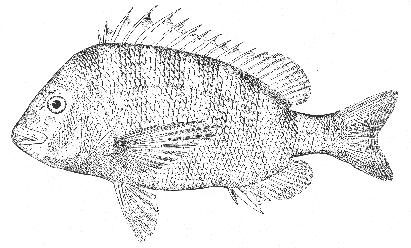Sheepshead Archosargus probatocephalus (Walbaum) 1792
[Jordan and Evermann, 1896-1900, p. 1361.]

Figure 216.—Sheepshead (Archosargus probatocephalus), North Carolina. From Goode. Drawing by H. L. Todd.
Description—
The sheepshead resembles the scup so closely in its general organization that the family relations between the two are obvious. Like the scup it is deep bodied and much flattened sidewise, with similar profile. It has one long dorsal fin, scuplike in outline, the anterior two-thirds of which is spiny (11 or 12 spines) and the posterior one-third is soft (11 to 13 rays). Its anal fin (3 spines and 10 or 11 rays) is about as long as the soft portion of its dorsal, under which it stands, and both the dorsal fin and the anal can be depressed in a deep groove. The pectorals are long and pointed; the ventrals are situated a little behind the latter; the scales are large; and the eyes are located high on the sides of the head; in all of which the sheepshead agrees with the scup. It is readily recognized, however, by the fact that its caudal fin is not so deeply emarginate as that of the scup, and has rounded corners instead of pointed ones, while its dorsal spines are alternately stout and slender; its second anal spine is much stouter than [page 417] that of the scup; the dorsal profile of its head is steeper; its nose is blunter; and its teeth are much broader. Furthermore, the body of the sheepshead is noticeably thicker, its back is rounded, and its sides show seven broad, dark brown or black crossbars on a gray or greenish yellow ground, instead of being plain colored like the sides of the scup.
Size—
The sheepshead grows to a length of about 30 inches and to a weight of 20 pounds.
General range—
Atlantic and Gulf of Mexico coasts of the United States from Texas to Cape Cod, and reported in the Bay of Fundy as a stray.
Occurrence in the Gulf of Maine—
The sheepshead was abundant as far north as New York formerly, and not uncommon about Woods Hole. It is common still to the southward. But it has been decidedly rare east of New York for many years past, although a number, about 6 inches long, were taken off Onset at the head of Buzzards Bay, in late August 1951.[66]
The only record of it north or east of the elbow of Cape Cod is Cox's[67] statement that it is occasional in St. John Harbor, New Brunswick. But no actual specimens are mentioned, and as it is not known ever to have strayed to Massachusetts Bay (a far more likely goal for any southern coast fish than the Bay of Fundy is), its claim to mention here is weak.